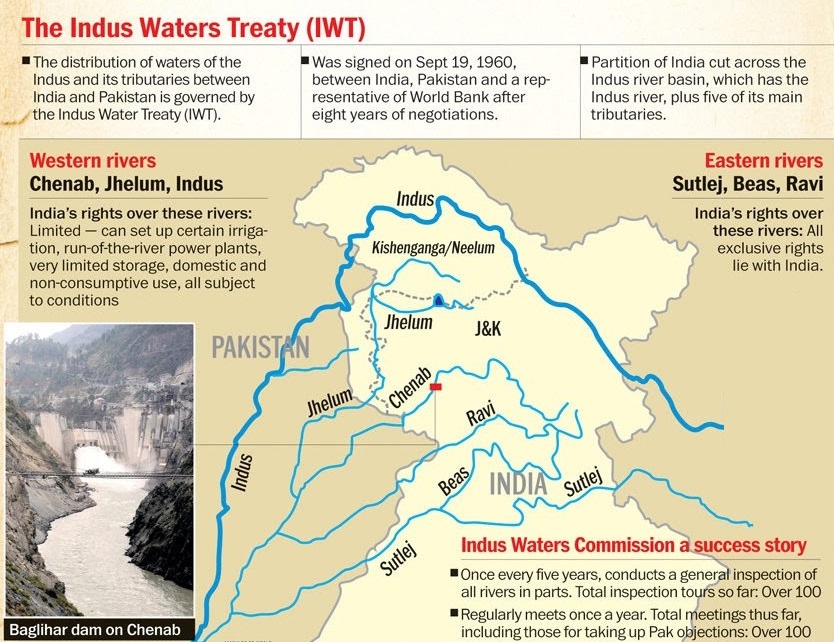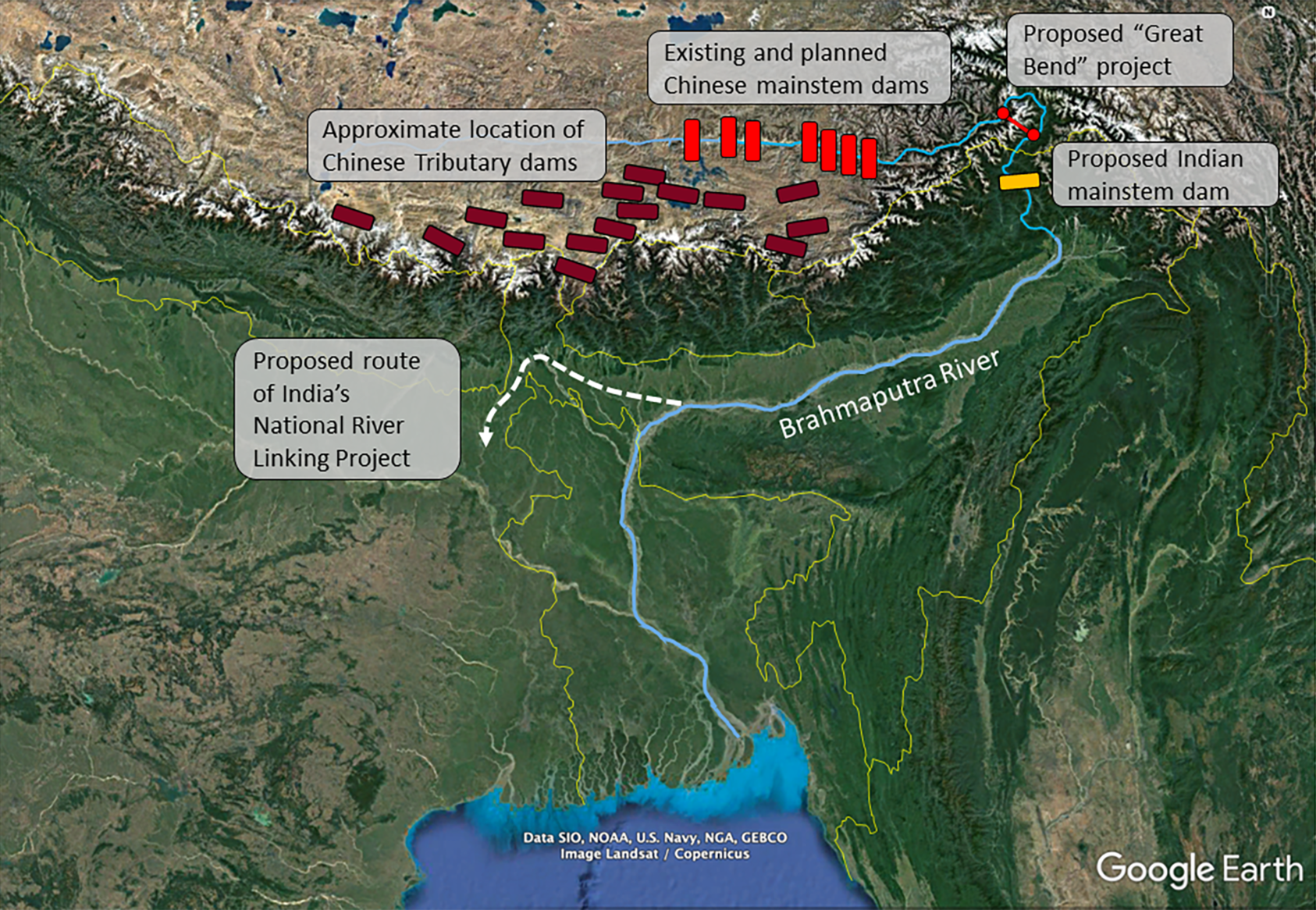The Geopolitics of water
2023 FEB 15
Mains >
International relations > India and Neighbours > water management
IN NEWS:
- India has issued a notice to Pakistan seeking modification of the 62-year-old Indus Waters Treaty (IWT) that governs the sharing of waters of six rivers in the Indus system between the two countries.
- Latest satellite images showed that China is building a new dam in Tibet on the Mabja Zangbo, a river that flows into Nepal’s Ghaghara or Karnali river before it joins river Ganga in India.
INDUS WATER TREATY:
- The Indus Waters Treaty (IWT) between India and Pakistan, brokered by the World Bank, dictates the terms of using the water available in the Indus River and its tributaries.
- The Treaty gives control over the waters of the three "eastern rivers" — the Beas, Ravi and Sutlej to India and the three "western rivers" — the Indus, Chenab and Jhelum to Pakistan.
- Thereby, India conceded 80.52 per cent of the aggregate water flows in the Indus system to Pakistan.
- But India can use 20% of the water in western rivers in “non-consumptive” needs, such as for irrigation and electricity production.

WHY IS INDIA SEEKING MODIFICATION?
- The dispute redressal mechanism provided under Article IX of the IWT is a graded mechanism. There are three possible steps to decide on objections:
- Working within the Permanent Indus Commission
- Consulting a World Bank-appointed neutral expert; or
- Setting up a court process to adjudicate the case through the World Bank and the Permanent Court of Arbitrage (PCA).
- Pakistan has objections on India’s construction of the Kishenganga hydroelectric project on the Jhelum River and Ratle Hydroelectric Project on the Chenab river.
- In August 2016, Pakistan approached the World Bank seeking the constitution of a Court of Arbitration whereas India moved a separate application asking for the appointment of a Neutral Expert. Since this resulted in parallel consideration of the same issue, the World Bank announced a “pause” in the processes initiated by India and Pakistan.
- In 2022, the World Bank decided to appoint a Neutral Expert and a Chairman for the Court of Arbitration.
- While India has held that each step must be fully exhausted before both sides agree to move on to the next step, Pakistan has approached the Permanent Court of Arbitrage at The Hague in the Netherlands without waiting for India’s concurrence.
- Citing what it called Pakistan’s “intransigence” in resolving disputes, India has given a notice with a request for a response within 90 days.
- The notice has invoked Article XII (3) of the treaty which says: The provisions of this Treaty may from time to time be modified by a duly ratified treaty concluded for that purpose between the two Governments.
GEOPOLITICS OF WATER:
- Civilizations are entirely dependent on water resources. So the transboundary nature of water makes it an important element in geopolitics.
- Water diplomacy can be defined as the use of diplomatic instruments to existing or emerging disagreements and conflicts over shared water resources with the aim to solve or mitigate those for the sake of cooperation, regional stability, and peace.
- Water diplomacy’s diplomatic instruments may include negotiations, dispute-resolution mechanisms, the establishment of consultation platforms, and the organization of joint fact-finding missions.
INDIA’S POSITION:
- The three major river systems in India - Indus, Ganga and Brahmaputra – are transboundary in nature.
- Indus river system:
- Most of the Indus Basin lies in India and Pakistan, and small portion of its total catchment is in Tibet and Afghanistan.
- The Indus Waters Treaty (IWT) between India and Pakistan dictates the terms of using the water available in the Indus River and its tributaries. Though Indus originates from Tibet, China has been kept out of the Treaty.
- In 2005, India signed a Memorandum of Understanding (MoU) with China on sharing hydrological information of the Sutlej River during flood Season by China to India. The MoU expired in November, 2020 and renewal of MoU is under process through diplomatic channels.
- Ganga river system:
- The Ganges River basin is spread across India, Nepal, China, and Bangladesh.
- India and Bangladesh signed the Ganges Water Sharing Treaty in 1996. The treaty established a 30-year water-sharing arrangement and recognised Bangladesh's rights as a lower-level riparian.
- India has also signed treaties with Nepal, such as the Mahakali Treaty of 1996, Kosi agreement of 1954 and Gandak Agreement, 1959.
- Brahmaputra River system:
- Brahmaputra flows through Tibet, India and Bangladesh.
- In 2002, India entered into a MoU with China for sharing of hydrological information of Brahmaputra during flood season by China to India. It was further renewed in 2008, 2013 and 2018.
- However, disputes over the appropriate allocation from the Teesta River remains a subject of conflict between India and Bangladesh.
NEED OF WATER DIPLOMACY:
- Rising demands:
- Owing to growth, demographically as well as economically amid increased concern from pollution and climate change, nations are increasingly facing water stress. To meet this situation peacefully, hydro-diplomacy is essential.
- Economic security:
- The perennial supply of water is the backbone of Indian agriculture. Besides irrigation, the rivers provide nutrient-rich deposits, cheap transport and fisheries. Hence, India needs to ensure that there is no threat to the supply of water.
- Eg: The Siang river, which joins the Lohit and the Dibang downstream to form the Brahmaputra, turned muddy and “blackened” in 2017 raising concerns about China’s upstream activities. This severely affected rice production in the Siang valley of Arunachal Pradesh.
- Energy security:
- India needs clean energy to fuel its development processes, and the transboundary Himalayan rivers have immense hydro power potential. To develop this potential within India an its neighbours like Nepal and Bhutan, India need water diplomacy.
- Leverage strategic advantage:
- Being the upper riparian offers apparent leverage vis-à-vis being lower riparian.
- For instance, being the upper riparian, India derives significant advantage out of the Indus River, which may be used as a strategic pressure point in the events of bilateral disputes.
- Reduce security concern:
- Water resources and infrastructure are prone to be casualties of a violent confrontation, either intentionally or accidentally. To reduce the vulnerability, hydro diplomacy is essential.
- Disaster management:
- Absence of data and water sharing agreements among the riparian states increases the threat of floods and droughts.
- For eg: Following the Doklam standoff, China withheld hydrological data for the Brahmaputra and Sutlej rivers, which aggravated the floods in Assam and Uttar Pradesh.
- Address climate change:
- Climate change is expected to intensify the hydrological cycle. To mitigate and adapt to it requires transboundary cooperation.
- For instance, researchers were able to map 562 glacial lakes in the Sutlej basin. To address the threat of glacial lake outburst floods, India and China need to cooperate.
- Ascertain territorial sovereignty:
- China and India are using dams as the new boundary markers and water investments as a way to build or assert regional power.
- For instance, India plans to construct the country’s second-largest dam at Yingkiong not only to counter the Great Bend Dam, but also to signal control over Arunachal Pradesh, which China claims to be “South Tibet.”

CHALLENGES:
- Shortage of necessary infrastructure:
- Due to absence of adequate infrastructure, India has been unable to utilise the full potential of its transboundary water resources. This reduces the effectiveness of water as a diplomacy tool.
- China’s investments:
- China has made significant investment in water infrastructure in the Brahmaputra, such as the Zangmu Dam. In addition, as per the Five-Year Plan 2011–15, China has planned to build 120 gigawatts of new hydropower plants on Brahmaputra, Mekong and other rivers. To compete with this, India would need significant resources and time.
- Weaponization of water:
- Often dubbed as ticking water bombs, the construction of several dams along the Brahmaputra on the Chinese side has been a cause for concern for India.
- Also, in times of conflict, upper riparian states may sabotage transboundary rivers by polluting them and rendering them unfit for use.
- China-Pak nexus:
- The growing collaboration between Pakistan and China on security, economy and water projects, primarily on the Indus basin, may lead the Chinese to become much more assertive towards India.
- Threat to India’s sphere of influence:
- Historically, India has been a regional hegemon on water relations with its smaller neighbors. However, China is using India’s perceived intransigence on water issues to build relationships with the neighbors.
- For example: India has not signed the 2011 Teesta agreement with Bangladesh. Now, China has offered to finance the dredging of the Bangladeshi section of the river and build additional storage to ensure dry season flows for transport.
- Absence of dispute resolution mechanism:
- Between India and China, there are no mutually agreed dispute-settlement mechanism on water sharing for the transboundary rivers. Also, China has openly refused to submit to international dispute settlements. This leaves very few diplomatic solutions available to India.
- Absence of enforcing mechanism:
- China has, on many occasions, violated the agreements it has with India on sharing of hydrological data.
- For instance, China provides data on Brahmaputra flows to India for USD 125,000 per year and has blamed occasional interruptions in data sharing on technical issues. However, Beijing has consistently provided the same data to Bangladesh at no cost.
- New realities:
- The variations in hydrology of rivers, rainfall patterns glacial melting due to climate change has altered the flow of the rivers. The basins are largely becoming deficit in water and hence conflicts are becoming frequent.
WAY FORWARD:
- Revise Indus treaty:
- Instead of contemplating abrogation or finding faults with the Indus treaty, India should seek to optimise the provisions by incorporating the lessons learned over the last 62 years.
- Develop counter coalition:
- India could lead a counter-coalition of countries that share rivers with China and forge a common institutional set-up for better transboundary management of shared rivers.
- Such an institution could also promote a “Southern Asian water information grid”, and aggregate best practices for sustainable water management.
- Strengthen domestic water management:
- Effective management of domestic water resources and rainwater is the best recourse to the threat pose by transnational rivers.
PRACTICE QUESTION:
Q. Discuss the impact of transboundary water disputes on India’s relationship with its neighbours.

